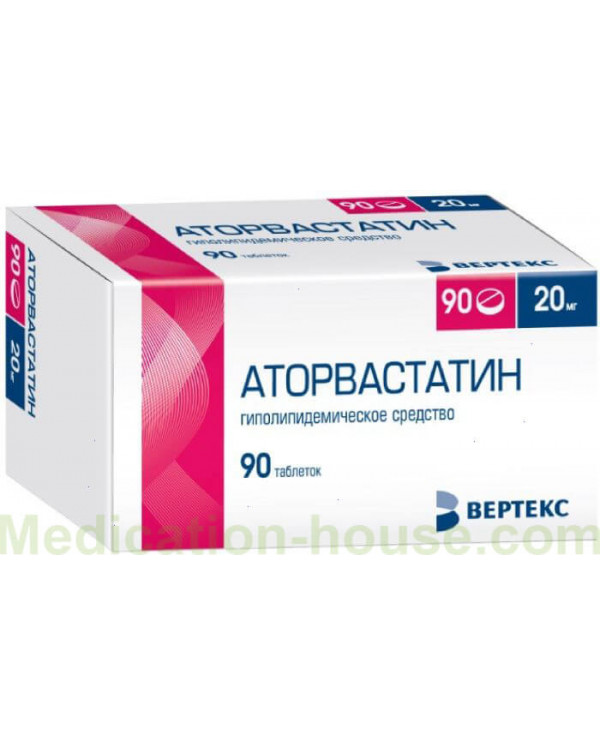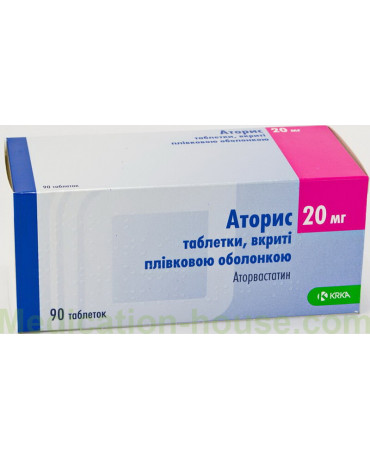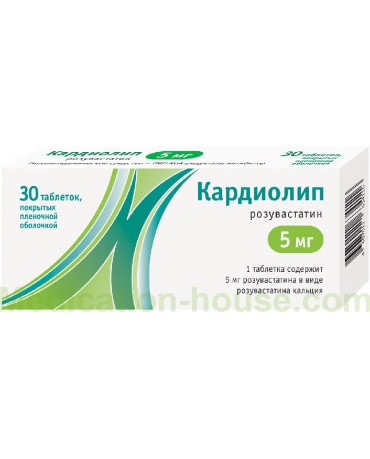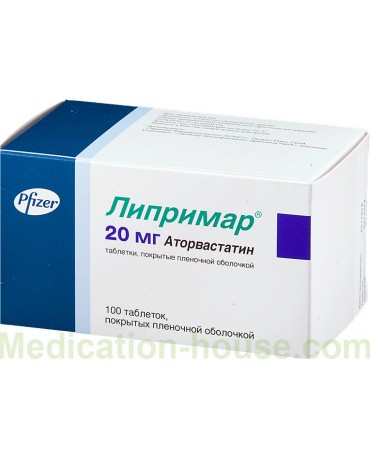User manual for Atorvastatin
You can buy Atorvastatin here
Atorvastatin is a lipid-lowering drug.
Composition
1 tablet contains:
active substance: atorvastatin calcium trihydrate - 10.85; 21.7; 43.4 or 86.8 mg, which is equivalent to 10; 20; 40 or 80 mg of atorvastatin, respectively;
auxiliary components: calcium carbonate, microcrystalline cellulose, colloidal silicon dioxide (aerosil), magnesium stearate, polyvinyl alcohol, StarKap1500 (corn starch, pregelatinized starch), macrogol (polyethylene glycol), titanium dioxide, talc; additionally for a dosage of 10 and 20 mg: lactose monohydrate (milk sugar); additionally for dosages of 40 and 80 mg: iron dye yellow oxide, iron dye red oxide.
Pharmacodynamics
Atorvastatin is a hypolipidemic drug that is a selective competitive inhibitor of HMG-CoA reductase (3-hydroxy-3-methylglutaryl-coenzyme A reductase) and the synthesis of mevalonic acid, an intermediate product of cholesterol and other sterols. Triglycerides (TG) and cholesterol enter the blood plasma and peripheral tissues in the liver through their incorporation into very low density lipoproteins (VLDL). During the interaction of VLDL with low density lipoprotein (LDL) receptors, LDL is synthesized. The mechanism of action of the drug is due to the ability of atorvastatin to lower blood plasma levels of cholesterol and lipoproteins. Due to inhibition of HMG-CoA reductase and production of cholesterol in the liver, the number of LDL receptors increases on the surface of liver cells. This causes a pronounced and sustained increase in the activity of LDL receptors, due to a decrease in the formation of LDL on the background of increased uptake and catabolism.
In homozygous familial hypercholesterolemia, which usually does not respond to lipid-lowering drugs, certain doses of Atorvastatin lower LDL levels. The action of the drug helps to reduce the level of total cholesterol by 30–46%, TG - by 14–33%, LDL - by 41–61%, apolipoprotein B - by 34–50%. Causes an increase in high-density lipoprotein (HDL) cholesterol and apolipoprotein A.
Pharmacokinetics
Atorvastatin calcium trihydrate is highly absorbed. After oral administration, the maximum concentration (Cmax) of atorvastatin in the blood plasma is reached after 1–2 hours. With the simultaneous intake of food, the absorption of the active substance is reduced, but this does not affect the lowering of LDL cholesterol. After taking the drug in the evening, the concentration level of atorvastatin is approximately 30% lower than after taking it in the morning. A linear relationship was established between the dose of the active substance and the degree of absorption.
The bioavailability of the drug is 12%, the systemic bioavailability of the inhibitory activity against HMG-CoA reductase is 30%.
The low level of systemic bioavailability is due to the fact that the metabolism of atorvastatin occurs in the mucous membrane of the gastrointestinal tract and during the first passage through the liver.
Plasma protein binding is 98%. The average volume of distribution is 381 liters.
Metabolism of atorvastatin in the liver occurs under the influence of isoenzymes CYP3A4, CYP3A5 and CYP3A7. Pharmacologically active metabolites are ortho- and parahydroxylated derivatives and beta-oxidation products. The inhibitory effect of the drug on HMG-CoA reductase is approximately 70% due to the activity of circulating metabolites.
T1 / 2 (half-life) is 14 hours. Active metabolites contribute to the preservation of the inhibitory effect of the drug against HMG-CoA reductase for 20-30 hours.
It is excreted mainly with bile through the intestine, without undergoing significant intestinal-hepatic recirculation, through the kidneys - up to 2% of the dose taken orally.
Cmax of atorvastatin in plasma in women is 20% higher than in men, and the total plasma concentration (AUC) is lower by 10%.
Cmax in alcoholic cirrhosis of the liver (class B on the Child-Pugh scale) increases approximately 16 times, AUC - 11 times.
Cmax is 40%, AUC is 30% higher in patients over the age of 65 than in young patients.
Functional disorders of the kidneys do not affect the level of concentration of atorvastatin in blood plasma and the degree of its effectiveness in relation to the parameters of the lipid profile. In case of impaired renal function, dose adjustment is not required.
During hemodialysis, the drug is not excreted.
Indications for use
The use of the drug is indicated in combination with a diet for the treatment of the following conditions:
elevated levels of total cholesterol (CS), LDL-C, TG and apolipoprotein B, low HDL-cholesterol levels in patients with primary hypercholesterolemia, heterozygous non-familial and familial hypercholesterolemia or mixed hyperlipidemia type IIa and IIb according to Fredrickson;
elevated serum TG levels (type IV according to Fredrickson);
dysbetalipoproteinemia of type III according to Frederickson - in the absence of an adequate effect from adherence to the diet.
In addition, Atorvastatin is prescribed to lower the level of total cholesterol and LDL cholesterol in patients with homozygous familial hypercholesterolemia, in the absence of a sufficient clinical effect from the use of non-pharmacological methods of treatment, including diet therapy.
Contraindications
active liver disease;
hepatic impairment class A and B on the Child-Pugh scale;
increased activity of liver enzymes (more than 3 times compared to the upper limit of the norm) of unknown origin;
period of pregnancy;
breast-feeding;
age up to 18 years;
hypersensitivity to the components of the drug.
According to the instructions, the drug should be prescribed with caution in chronic alcoholism, a history of liver disease, arterial hypotension, uncontrolled epilepsy, severe electrolyte imbalance, metabolic and endocrine disorders, severe forms of acute infections (sepsis), skeletal muscle diseases, trauma, extensive surgical operations.
Instructions for the use: method and dosage
Treatment should take place while the patient is adhering to a standard lipid-lowering diet.
The tablets are taken orally, regardless of food intake, once a day at any convenient time.
The doctor prescribes the initial dose taking into account the individual baseline level of LDL-C and clinical indications. Further, it can be adjusted depending on the therapeutic effect.
At the beginning of the drug use and at each dose increase, you should regularly (every 14-28 days) check the level of lipids in blood plasma in order to adjust the dose accordingly.
The initial daily dose is on average 10 mg, the maximum daily dose is 80 mg.
With simultaneous treatment with cyclosporine, the dose of Atorvastatin should not exceed 10 mg per day.
Recommended daily dosage:
primary hypercholesterolemia, mixed hyperlipidemia of type IV according to Fredrickson with an increased serum TG level, dysbetalipoproteinemia (type III according to Fredrickson): 10 mg each. A sufficient therapeutic effect occurs after 14 days of taking the tablets, the maximum - after 28 days and remains on the background of long-term therapy;
homozygous familial hypercholesterolemia: 80 mg each.
In renal failure and in elderly patients, dose adjustment is not required.
Patients with hepatic impairment should reduce the dose of Atorvastatin.
Side effects
from the respiratory system: often - rhinitis, bronchitis; sometimes - exacerbation of bronchial asthma, dyspnea, epistaxis, pneumonia;
from the nervous system: often - dizziness, insomnia; sometimes - malaise, drowsiness, headache, nightmares, migraine, asthenia, paresthesia, emotional lability, peripheral neuropathy, ataxia, hyperkinesis, facial paralysis, depression, hypesthesia, amnesia, loss of consciousness;
from the hematopoietic system: sometimes - thrombocytopenia, anemia, lymphadenopathy;
on the part of the cardiovascular system: often - chest pain; sometimes - palpitations, increased blood pressure (BP), orthostatic hypotension, symptoms of vasodilation, arrhythmia, angina pectoris, phlebitis;
from the digestive system: often - nausea; sometimes - dry mouth, constipation, diarrhea, heartburn, abdominal pain, dysphagia, vomiting, flatulence, gastralgia, decreased or increased appetite, belching, glossitis, esophagitis, stomatitis, erosive and ulcerative lesions of the oral mucosa, bleeding gums, tenesmus, rectal bleeding, melena, cheilitis, duodenal ulcer, gastroenteritis, biliary colic, pancreatitis, liver dysfunction, cholestatic jaundice, hepatitis;
from the senses: sometimes - ringing in the ears, deafness, amblyopia, dry conjunctiva, retinal hemorrhage, glaucoma, accommodation disorder, parosmia, taste perversion, loss of taste;
from the musculoskeletal system: often - arthritis; sometimes - muscle hypertonia, leg muscle cramps, joint swelling, bursitis, tendosynovitis, myopathy, myositis, arthralgia, myalgia, torticollis, rhabdomyolysis, tendonitis (including tendon rupture), joint contractures;
from the endocrine system: sometimes - mastodynia, gynecomastia;
from the genitourinary system: often - peripheral edema, urogenital infections; sometimes - dysuria (including pollakiuria, nocturia, urinary incontinence, urinary retention or urge to urinate), nephritis, leukocyturia, hematuria, nephrourolithiasis, epididymitis, vaginal bleeding, metrorrhagia, decreased libido, ejaculation disorder, impotence;
from the side of metabolism: sometimes - an increase in body weight, exacerbation of gout;
allergic reactions: sometimes - itchy skin, rash, contact dermatitis; rarely - urticaria, facial edema, angioedema, toxic epidermal necrolysis (Lyell's syndrome), exudative erythema multiforme (including Stevens-Johnson syndrome), anaphylaxis;
dermatological reactions: often - photosensitization, alopecia, xeroderma, increased sweating, ecchymosis, petechiae, eczema, seborrhea;
laboratory parameters: sometimes - hypoglycemia, hyperglycemia, albuminuria, increased serum creatine phosphokinase.
Overdose
Symptoms: not established.
Treatment: there is no specific antidote. In case of taking a high dose of the drug, symptomatic therapy is prescribed. Hemodialysis is ineffective.
Special instructions
Before prescribing the drug, it is recommended to try to control hypercholesterolemia by adhering to an adequate diet, increasing physical activity, reducing body weight with obesity, and treating conditions that cause the disease.
The use of the drug should be accompanied by monitoring of liver function. Studies are carried out before the start of therapy, after each dose increase, after 1.5 and 3 months, and then periodically once every 6 months. With an increase in the activity indicators of liver enzymes in the blood serum, the condition of the patients is monitored until their normalization. If the values of alanine aminotransferase or aspartate aminotransferase exceed the upper limit of the norm by more than 3 times, it is recommended to lower the dose of atorvastatin or temporarily stop taking the tablets.
Against the background of the use of the drug, the development of myopathy is possible, which requires the cancellation of therapy. Signs of this disease are widespread myalgia, soreness or muscle weakness with a pronounced increase (more than 10 times compared to the upper limit of the norm) in the activity of creatine phosphokinase (CPK). With a pronounced increase in CPK activity, treatment must be discontinued. It is required to take into account that the biotransformation of Atorvastatin occurs under the influence of the isoenzyme CYP3A4, therefore, care should be taken when using it simultaneously with drugs that inhibit the transport of drugs and / or metabolism, which is mediated by this isoenzyme. A careful assessment of the expected clinical effect and the possible risk of myopathy is needed when atorvastatin is prescribed in combination with erythromycin, azole antifungal agents, fibrates, immunosuppressants, nicotinic acid in hypolipidemic doses. If it is necessary to prescribe the drug in combination with these agents, the patient's condition requires regular monitoring for the appearance of pain or weakness in the muscles, including during the first months of joint therapy or when the dose of any agent is increased. Systematic control of CPK activity does not prevent the development of severe myopathy.
When prescribing the drug, patients should be informed of the need to immediately consult a doctor if pain or weakness in the muscles of unknown etiology, accompanied by malaise or fever, appears.
There is a risk of developing rhabdomyolysis with acute renal failure caused by myoglobinuria. In the event of signs of myopathy, severe acute infection, arterial hypotension, severe metabolic, endocrine and electrolyte disturbances, uncontrolled seizures, serious injury or extensive surgery, treatment with atorvastatin is temporarily or completely stopped.
Influence on the ability to drive vehicles and complex mechanisms
Taking Atorvastatin tablets can cause dizziness, so patients should be careful when driving and working with complex mechanisms.
Application during pregnancy and lactation
The use of Atorvastatin during gestation and lactation is contraindicated.
If it is necessary to prescribe the drug during lactation, it is recommended to stop breastfeeding.
Women of reproductive age should be informed about the need to use reliable contraceptive methods and the possible risk to the fetus in case of conception while taking the drug.
Childhood use
Due to the lack of information on the safety and efficacy of Atorvastatin in the treatment of children and adolescents, the appointment of the drug under the age of 18 is contraindicated.
With impaired renal function
No dose adjustment is required for patients with kidney disease.
For violations of liver function
The use of the drug is contraindicated for the following violations of liver function:
hepatic impairment class A and B on the Child-Pugh scale;
active liver disease;
an increase in the activity of liver enzymes (in comparison with the upper limit of the norm by more than 3 times) of unknown genesis.
In the treatment of patients with hepatic impairment, a dose reduction is required.
Use in the elderly
No dose adjustment is required for elderly patients.
Drug interactions
erythromycin, clarithromycin, quinupristin / dalfopristin (antibiotics), cyclosporine, indinavir, ritonavir, antifungal agents of the azole group (itraconazole, ketoconazole, fluconazole), nefazodone, nicotinic acid; development of myopathy with acute renal failure and rhabdomyolysis;
suspension containing magnesium hydroxide and aluminum hydroxide: causes a decrease in the level of atorvastatin in blood plasma by about 35%, but does not affect the degree of decrease in the level of cholesterol-LDL;
antipyrine (phenazone) and other drugs metabolized by isoenzymes of the cytochrome P450 system; warfarin, cimetidine; antihypertensive drugs: drug interactions are not expected;
colestipol: there is a decrease in the concentration of atorvastatin in the blood plasma by about 25%, however, the hypolipidemic effect from the combination of the two drugs is achieved higher than from taking each of them separately;
digoxin: while taking atorvastatin in a daily dose of 80 mg, the level of digoxin in the blood increases by 20%;
erythromycin, clarithromycin: taking erythromycin in a daily dose of 2000 mg or clarithromycin - 1000 mg (inhibitors of the isoenzyme CYP3A4), causes an increase in the concentration of atorvastatin in the blood plasma;
oral contraceptives containing norethindrone or ethinyl estradiol: it should be taken into account when choosing a contraceptive for oral administration, that the AUC of norethindrone increases by about 30%, ethinyl estradiol - by 20%;
cimetidine, ketoconazole, spironolactone and other drugs that reduce the concentration of endogenous steroid hormones: the risk of lowering endogenous steroid hormones increases;
grapefruit juice (CYP3A4 inhibitors): contributes to a clinically significant increase in the concentration of atorvastatin in blood plasma;
efavirenz, rifampicin and other inducers of the isoenzyme CYP3A4: cause a decrease in the concentration of atorvastatin in blood plasma;
terfenadine and other drugs metabolized with the participation of the CYP3A4 isoenzyme: their pharmacokinetic parameters do not change;
azithromycin: while taking azithromycin in a daily dose of 500 mg, the concentration of atorvastatin (10 mg) in the blood plasma does not change;
amlodipine: concomitant therapy with amlodipine at a dose of 10 mg while taking atorvastatin at a dose of 80 mg does not cause changes in the pharmacokinetics of the latter in an equilibrium state.
Pharmaceutical incompatibility has not been established.
Terms and conditions of storage
Keep out of the reach of children.
Store at temperatures up to 25 ° C, protected from light and moisture.
The shelf life is 3 years.
Reviews
Reviews of Atorvastatin are positive. Patients indicate the high efficacy of the drug in controlling blood cholesterol levels. Generally, they note the good tolerance and affordable price of the drug. At the same time, they note the need to simultaneously comply with a strict diet.
Terms of sell
You can buy Atorvastatin without a prescription.




